
More and more of us are making a change. We’re making the decision to turn away from single-use menstrual products and embrace reusable, zero waste alternatives instead. A menstruating person uses an average of 11,000 pads and tampons in their life, sending 250 to 300 pounds of period-related waste to the landfill which won’t break down for hundreds of years. And that’s not even including the environmental impact of manufacturing, packaging, and shipping all those products.
The menstrual product market is worth an estimated 40 billion dollars worldwide, so it’s worth pointing out that not only are reusable period products more eco-friendly, they’re typically more economical too. With so many people here in the US and Canada and around the world struggling to afford and to access menstrual hygiene products, it’s past time to look at alternatives.
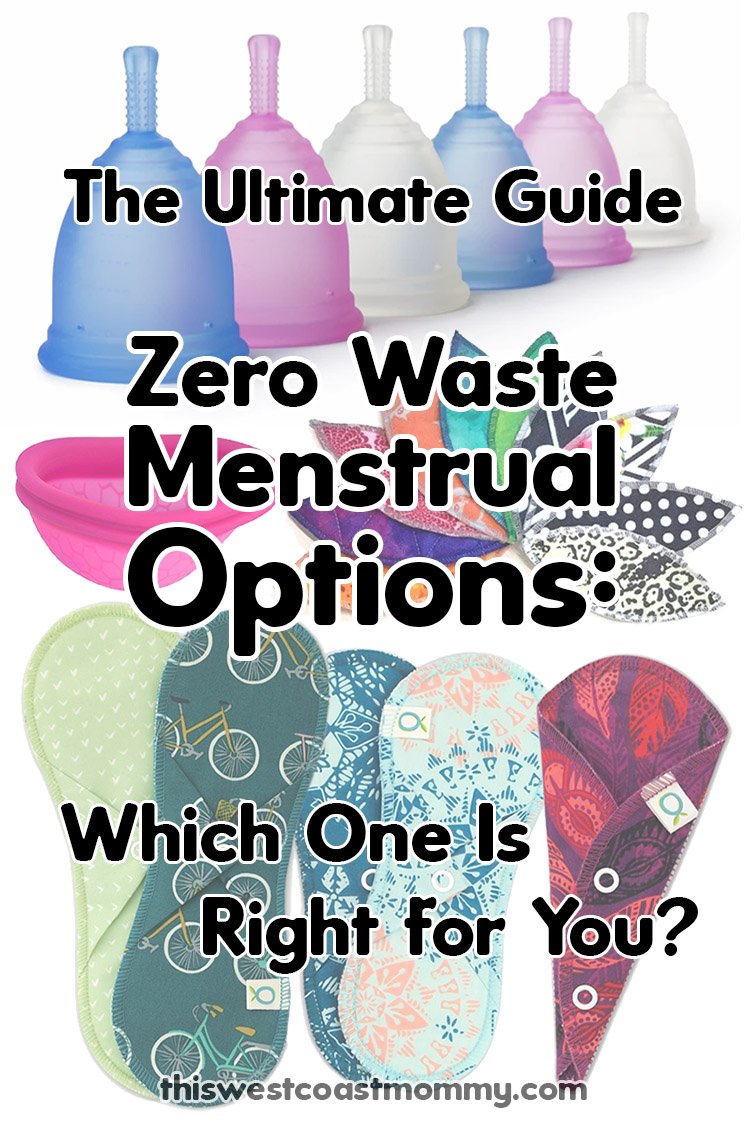
You’ve probably heard of cloth pads and menstrual cups, but there are actually a whole range of options, worn both externally and internally. Here’s a brief overview to help you decide which one(s) are right for you.
Reusable Cloth Pads
Instead of plastic and paper single-use maxipads, reusable pads are made from fabric that you can use and reuse every cycle for five or more years. You can find an almost limitless range of options including cotton, hemp, minky, fleece, bamboo, or even raw silk. Just like disposable pads, reusable pads come in a variety of absorbencies, shapes (extra long, thong, etc.), and uses (postpartum, overnight, pantyliners, etc.)
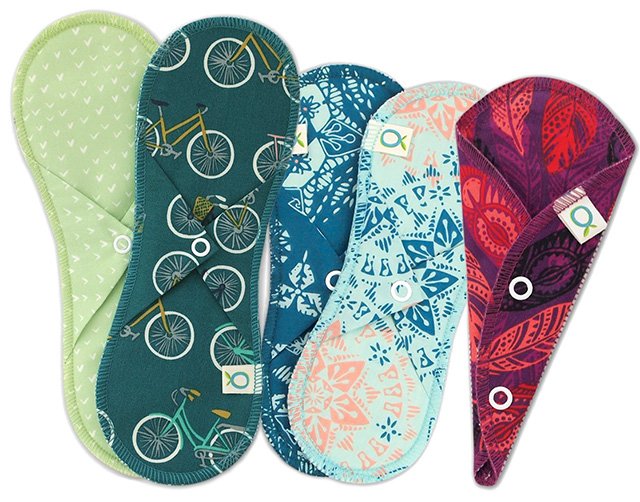
Öko Créations reusable cloth pads are made from hemp fleece/organic cotton pads and come in regular, long, pantyliner, mini pantyliner, and thong styles.
Some pads are “all-in-one,” like these Öko Créations hemp fleece pads. These are closest in style to store-bought disposable pads, though they typically snap around the gusset of your underwear rather than using an adhesive strip. Some styles are made with a pocket or envelope in which you can tuck inserts of varying absorbency. Other pads have a waterproof base layer to which you add an absorbent insert on top, typically held in place by elastics.
Cool tip: Get 15% off Öko Créations cloth pads with code OKO.LOVE.OLIVIA
More rarely, you may find pads that are worn with a belt, reminiscent of the belted pads our grandmothers used to use. These are suitable for people who don’t use underwear or who prefer to wear undergarments that don’t have a gusset suitable for pads to snap around (e.g. boxers).
Pros of Cloth Pads:
- Come in a wide variety of shapes, styles, and materials to suit everyone
- Simple to use
- No risk of TSS or infections
- Can sew your own DIY pads
Cons of Cloth Pads:
- Significant start-up cost
- May bunch up or slip
- Larger pads may feel bulky
- Can not wear for swimming
Cleaning: Rinse in cold water then wash with regular laundry or hand wash.
Cost: $$$-$$$$
Menstrual Cups
When it comes to internal options, most of us have heard of reusable menstrual cups as a replacement for disposable tampons. Did you know that the first menstrual cups were made from rubber and patented in the 1930s? They weren’t commercially successful though, and it wasn’t until the last decade or so that menstrual cups have became better known and widely available.
A menstrual cup is inserted into the vagina where it sits in the canal just below the cervix to catch blood internally. There is definitely a learning curve to using these correctly, but not too much more than learning to use a tampon. Since cups are made from non-absorbent material, they don’t dry out vaginal walls like tampons and are less likely to cause microtears that can let in bacteria or toxins.
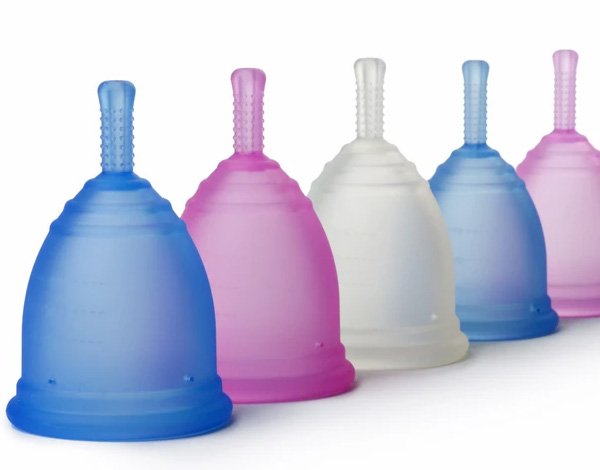
The Ruby Cup comes in 2 sizes and lasts 10 years. For every cup sold, another cup is donated to a girl or woman without access to menstrual products in a developing country.
There’s a wide variety of menstrual cups made to fit a wide variety of users. Popular brands include Ruby Cup, Lunette Cup, DivaCup, and Luna Cup. Cups are typically made from medical-grade, hypoallergenic silicone (but for those who want to avoid silicone, the Keeper Cup is made from natural latex rubber).
Menstrual cups can last anywhere from 3-10 years, making them a great economical choice. Most users find they only need to empty their cup every 12 hours, and they’re safe and comfortable to sleep or swim in. The cup should be rinsed clean with water every time you empty it, and boiled at the end of every cycle to clean and sanitize before your next cycle.
Pros of Menstrual Cups:
- Come in a wide variety of shapes and lengths to fit most bodies
- Can wear for swimming
- Does not dry out mucous membranes
- Can hold a lot of blood so fewer changes needed
- Reduced risk of TSS (but not zero)
- Non-porous material is easy to clean and sanitize
Cons of Menstrual Cups:
- Significant learning curve
- May require trial and error to find the right fit
- Inconvenient to clean in public washrooms
Cleaning: Wash with mild soap and water every time you empty. Boil at the end of every cycle.
Cost: $$-$$$
Menstrual Discs
Newer flat disc designs like Intimina Ziggy, Lumma, and Nixit also catch blood internally, but their lower profile fits differently and allows for penetrative sex while the disc is in place. Insertion is a little bit different due to the shape, but most who’ve used them find they fit and contain blood just as well if not better than traditional menstrual cups.
Like cups, discs are inserted into the vaginal canal but they sit higher up and tucked behind the pubic bone. Because these are inserted further up, you should expect to really “get in there” with your fingers when inserting and removing. You should also expect more mess when removing a disc as they’re more likely to spill.
Pros of Menstrual Discs:
- Can wear for swimming
- Can wear during sex
- Does not dry out mucous membranes
- Can hold a lot of blood so fewer changes needed
- Reduced risk of TSS (but not zero)
- Non-porous material is easy to clean and sanitize
Cons of Menstrual Discs:
- Significant learning curve
- Fewer shape/size options
- More costly than menstrual cups
- May require trial and error to find the right fit
- Inconvenient to clean in public washrooms
- Insertion and removal can be messier than menstrual cups
Cleaning: Wash with mild soap and water daily. Boil at the end of every cycle.
Cost: $$$
Menstrual Underwear
Menstrual underwear (also called period panties) have a sewn-in ultra thin, absorbent stay-dry layer in the gusset, or use a sewn-in pocket to securely hold a removable absorbent insert. Depending on your flow, these can either completely replace any other menstrual product or act as a leak-proof back-up.
The nice thing is there’s nothing to slip or bunch up, and they come in various styles (bikini, boy short, brief, thong, boxer brief, etc.) just like standard panties. Popular brands include Luna Undies, Knix, and Rubylove (Rubylove also makes period swimwear). But period underwear isn’t cheap (expect to pay $20-$30 per pair), and unless you’re planning to do laundry every single day of your period, you’re going to need a few pairs.
Pros of Period Underwear:
- Wide variety of styles and sizes to suit just about everyone
- Simple to use
- No risk of TSS or infections
Cons of Period Underwear:
- Best for light or medium flow
- Can not wear for swimming
- Costly start-up
Cleaning: Rinse in cold water and wash with regular laundry or hand wash.
Cost: $$$$
Reusable Cloth Tampons
For those who don’t want to give up tampons but still want to reduce their footprint, there are reusable tampons. Typically made from cotton, cotton flannel, or crocheted yarn with a string attached, most are made to unroll for washing and drying. That’s a smart idea, since the last thing you want is for the fabric to be less than completely clean and dry after use. Since these are worn internally, it’s critical to sanitize before using and after every use to avoid introducing harmful bacteria into your vagina.
To insert a reusable tampon, you just roll it up and basically push it up inside. If you feel like an applicator is necessary, consider investing in a reusable applicator for a plastic-free period. It’s important to note that reusable tampons are not currently safety tested or approved by the FDA or CPSA for internal use.
Pros of Reusable Tampons:
- Familiar style for most
- Can wear for swimming
Cons of Reusable Tampons:
- Drying on mucus membranes
- Unregulated products are not safety-tested
- Risk of TSS unknown
- Absorbent material is harder to sanitize
- May be uncomfortable to insert without an applicator
Cleaning: Rinse in cold water then wash in a laundry bag with regular laundry or hand wash.
Cost: $-$$
Interlabial Pads
You may not have heard of interlabial pads before. These are definitely a more unusual option, but some people swear by them. These small leaf or teardrop-shaped pads are folded or rolled, then tucked into place between the labia and against the vaginal opening. You might be wondering how and if they stay in place. Surprisingly, the labial placement holds these miniature pads quite securely, even without any external fastener.
Interlabial pads are best suited for light flow days or to protect underwear/clothing from vaginal discharge. They can also be used as back-up for a cup or paired with a traditional cloth pad to “direct” your flow into the centre of the pad. One of the biggest drawbacks to wearing an interlabial pad is you must remember to remove it before peeing or you’ll end up fishing it out of the toilet bowl.
Pros of Interlabial Pads:
- No need for any particular style of underwear or underwear at all
- Easy to sew your own interlabial pads
- Works well to reduce leaks from “gushes”
Cons of Interlabial Pads:
- Not suitable for heavy flow on their own
- Must be removed before using the toilet
- Can not wear for swimming
- Drying on mucus membranes
Cleaning: Rinse in cold water and wash in a laundry bag with regular laundry or hand wash.
Cost: $-$$
Sea Sponges
Sea sponges are exactly what they sound like. Cleaned and shaped pieces of sea sponge that are inserted into the vagina to absorb blood. They’re good at expanding to fit pretty much any vaginal canal, but many users find removing sponges more challenging and significantly messier than other internal options (it’s a sponge filled with blood after all).
Sponges typically last an average of 6 months before they start to break down which means they must be replaced more often than other options, increasing their cost. However, sponges are compostable when they’re ready for disposal.
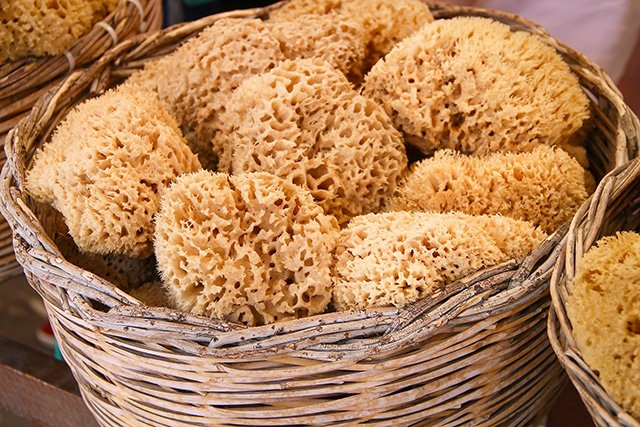
Sea sponges are not currently safety tested or approved by the FDA or CPSA for internal use. Since sponges are the remains of a formerly living undersea animal, they may contain sand, bits of shell, or other debris that hasn’t been completely cleaned before packaging. Previous samples have been found to contain yeast and mould. Small pieces of sponge can also tear off and get left behind, and porous sponges are harder to clean than menstrual cups. For these reasons, when it comes to reusable internal menstrual options, it’s best to stick to safer options like a menstrual cup.
Pros of Sea Sponges:
- Easy to trim into preferred, comfortable shape
- Soft sponge expands to fit most
- Can wear for swimming
- Can wear during sex
- Compostable
Cons of Sea Sponges:
- Unregulated products may contain sand or other debris
- Risk of TSS unknown
- Significant learning curve
- Needs to be replaced more often than other options
- Absorbent material is harder to sanitize
- Removal is often messier than other options
- Inconvenient to remove or clean in public washrooms
Cleaning: Clean with mild soap or soak in a solution of water and vinegar or water and hydrogen peroxide.
Cost: $$$-$$$$
Free Bleeding
And then there’s a final option that’s not for everyone, but it’s definitely zero waste. Free bleeding is sometimes defined as not collecting menstrual blood internally in a tampon or a cup (i.e., using a pad or menstrual underwear instead), but it’s usually understood to mean not using any menstrual products at all, for either part or all of your period. There’s this blog post from All about My Vagina describing one woman’s experience with free bleeding. You may also remember Kiran Gandhi who provoked both international praise and outrage when she ran the London Marathon in 2015 while free bleeding.
A feminsty piece I wrote for Absurdist about bleeding freely at the 2015 London Marathon – http://t.co/IthRlQFGuG pic.twitter.com/rs3C0gs7iO
— Madame Gandhi (@MadameGandhi) July 21, 2015
Embedded in this discussion is the understanding that while free bleeding may be a choice for some, it isn’t a choice for hundreds of millions of girls and women around the world who simply don’t have the resources to access menstrual products at all.
When girls don’t have access to sanitary and menstrual products, they are more likely to miss school or drop out because of hygiene and stigma concerns, and an interrupted education increases their likelihood of child marriage, domestic violence, early pregnancy, and pregnancy complications. So for some people, free bleeding is also a political act that draws attention to the plight of millions of people facing period poverty and the stigma of menstruation.
Pros of Free Bleeding:
- No menstrual supplies needed
- Lowest cost
Cons of Free Bleeding:
- Social stigma
- Hygiene concerns
- Stains on clothing or furniture
- Requires access to water, laundry, and sanitation supplies
Cleaning: Soak blood stains in cold water and pre-treat with Oxi-Clean or hydrogen peroxide before laundering.
Cost: $
A Reusable Menstrual Option for Everyone
Making the switch is easier than you might have thought! Switching to one or more of these reusable options can save you money and help save the planet. Personally, I’ve found great success with using a menstrual cup for most of my cycle and a reusable cloth pad as back up or on really light days.
Whichever of these options is right for you, you’ll be helping reduce your carbon footprint and reduce some of that waste sitting in the landfill.


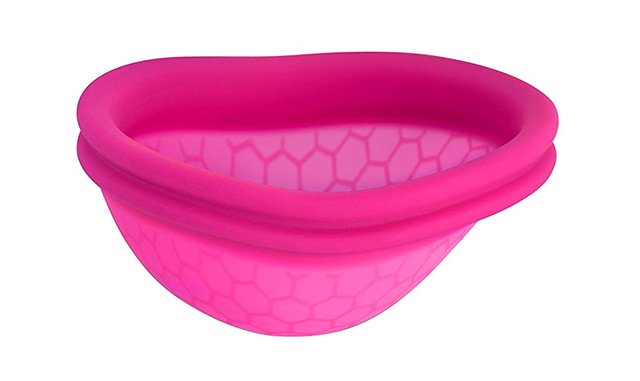
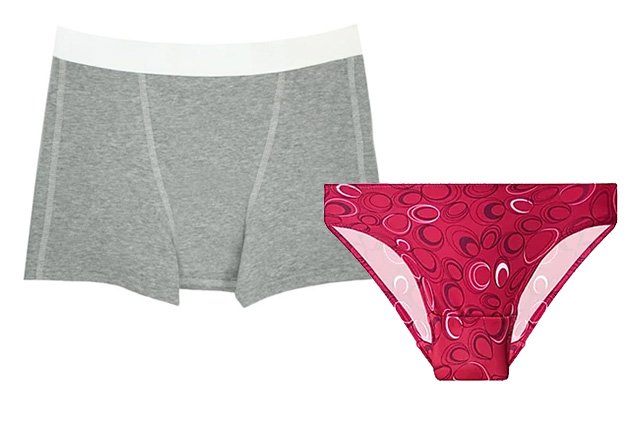

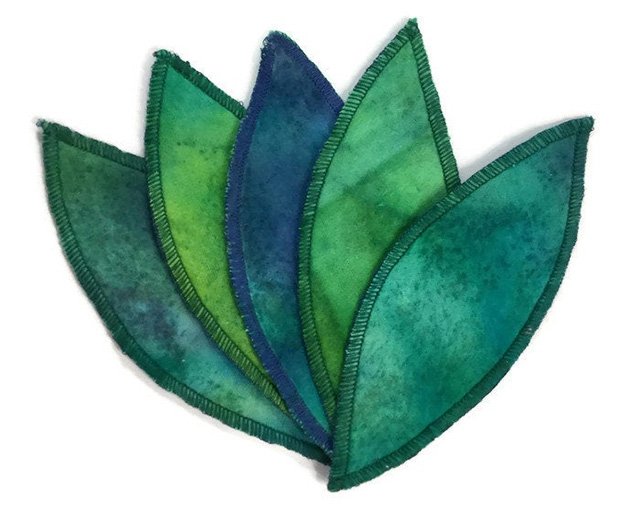
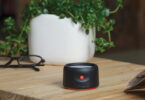

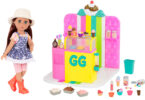



I have used cloth pads and cups. I have never been able to find the right cup as I’m low income. It took a while but found which kind of pads are right for me
I’ve used a reusable pad before. It worked well but the velcro fastener scratched my leg.
I have used the cup and cloth pads. I have not tried cloth pads by oko creations but open to trying a different companies creation/make and see what selection they have.
I have a few cloth pads and liners, and love them a lot, but find I can’t use them on my heavy days as they don’t handle clots and gushes as well as disposables. I’m hoping to slowly expand my stash and in the process find a few that do work well for those days as well.
I also have a cup and need to try it again( Gave up as I have PFD and it makes it harder to place the cup properly so it doesn’t fall out when I sit on the toilet and chafe the rest of the time.)
I haven’t used anything reusable yet! I did purchase a cup though.
I’ve never tried anything like this before. Very good post explaining pros and cons of all these new choices
I’ve been using a Diva Cup and Oko Pads got about 6 months now and love them! Especially when I think of the garbage can full of waste I used to generate with my period!
I have not used any products.
I’ve used a reusable pad before and it worked well for me.
I have not tried any. I like the eco-friendly aspect!
These menstrual cups sound interesting!
I have tried both menstrual pads and cups. I really like the cups and they work great once you figure them out.
I’ve tried and then bought cloth pads. I was surprised at how well they work and easy to wash.
I had no idea there were so many options. I would like to try the period underwear and the reusable pads.
I use reusable pads, however i really want to try a menstrual cup, I’m just a bit nervous!! I set a goal for myself to try it this year 🙂
I haven’t tried anything reusable but I have always wanted to try reuasable liners.
i tried cloth pads but found them shift around too much
I haven’t tried any of the options above, but I’ve been hearing a lot about menstrual underwear and would like to try it out.
I own a ZiggyCup (disc) which constantly leaks! I have to replace the 5-year-old DivaCup that I have (hello, Ruby Cup!).
I haven’t tried any of the reusable menstrual products yet but I would love to try the menstrual cup. It seems like the easiest option for me .
I would love to try the reusable pads!
I have always wanted to try menstrual cups. They seem a lot less intimidating than I originally thought they were, and I love how they last for 10 years. I wonder if there’s a way to make sure that bacteria doesn’t grow on them throughout the day, or if TSS is an issue. I sure hope not. I want to give it a try!
I have user the diva cup in the past and would definitely want to use it again. They are a lot cleaner and less messy than you may originally expect, and really convenient. I lost mine a while back and a new one would be awesome. It feels good to help the planet!
I am interested in using cloth pads.
Love my OKO pads!
I have not tried any of these because I had a hysterectomy years ago but I have two teenage girls living here and would love to give them some other options. I am sure that at least one of them would be very interested in the OKO products and the reusable menstrual cup.
I use a cup and cloth pads for back up and light flow days. I wish I had known about these options as a teen!
I have tried menstrual cups and use one regularly. I’m very interested in trying reusable pads.
I have never used reusable items before. This is all new to me 🙂
I have used a cup & reusable pads.
I definitely can’t do the free bleeding but I am interested in switching to the cup with the reusable pads as backup. I really want to know how much they absorb compared to disposables, And how much work is it to wash them.
I use cloth pads and have just recently bought a pair of period panties. I would like to try a cup, but the learning curve and sizing is what has held me back so far.
I really like Oko. I have used and they are comfy.
I just made the switch to a menstrual cup recently after much internal debate and hesitancy. I was pleasantly surprised by how easy it was to insert (after watching several videos) and how mess free it was. I’d like to start using cloth pads as a backup, but have yet to make that investment.
I use cloth pads and love them.
I have only ever tried cloth pads before. I’d definitely like to try a menstrual cup.
My wife uses these. I’m not sure the brand but I know she’s about to get a set for our 13 year old daughter as well. She says she has been totally relieved of cramping since starting to use reusable cloth pads. It also seems to have shortened her cycle, so.. thanks for that lol.
I would like to give the cup a try. Seems like a significant long term cost savings.
Great article. Very informative. I haven’t used any of these products but I am now very interested in the cup
I have a Diva cup and I love it. I’ve talked a few people at work into trying them as well
I have only tried the Meluna cup but didn’t like it. I’d love try to others!
daughter has tried a few
This is amazing!! I’ve always been interested in trying these, especially to help our environment!
Ive never really thought about these but this post is super informative and made me want to try!
I’ve been meaning to try one of the diva cups . They’re a lot safer to use as well .
useful info – thank you! this can helps us make a difference in the amount of feminine products in the landfills.